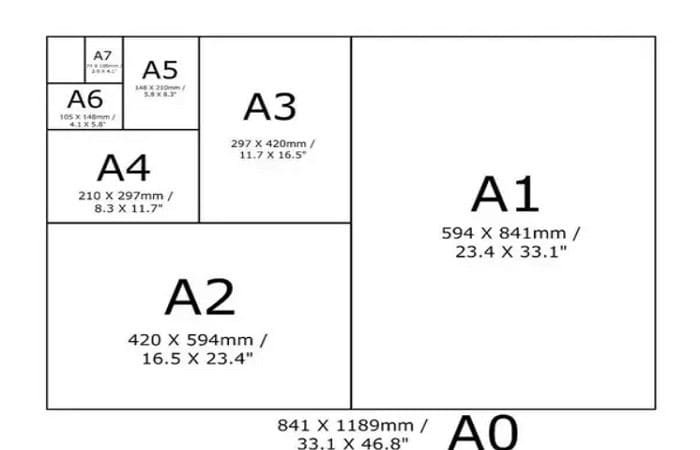If you are a young artist unsure about what sort of paper to use and what size to use for your presentation, or if you have yet to learn what architectural paper is, read this article until the end for a full explanation.
The finished product will always create on a standard architectural paper size, regardless of the medium you select to create your designs. Architectural paper size is beneficial for identifying the boundaries of the document, even for digital files.
This article will delve into the various standard sizes used for architectural paper and the types of drawings typically associated with each size. We will also discuss the importance of clear and accurate communication in architecture, ANSI A, B, C, and D, and how standard paper sizes contribute to this goal.
See Also: A Paper Size Scale & Magnification Factors
Table of Contents
What Is An Architectural Paper Size?
Architectural paper sizes refer to the standardized dimensions of sheets used to produce architectural drawings and blueprints. These sizes are typically more significant than a standard letter or legal-size paper and are used to accommodate architectural drawings’ detailed and precise nature. Organizations such as American National Standards Institute (ANSI) and the International Organization for Standardization (ISO) have established the standard size of blueprints and architectural drawings. Check this out if you want to change your paper sizes in Word.
Organizations such as American National Standards Institute (ANSI) and the International Organization for Standardization (ISO) have established the standard size of blueprints and architectural drawings. Check this out if you want to change your paper sizes in Word.
These sizes are used worldwide and help ensure that drawings can be easily reproduced and shared among professionals and organizations involved in a construction project.
ANSI A: The Most Common Size for Blueprints
The most common standard for blueprint standard size is ANSI A, which measures 22 inches by 34 inches. This size uses for construction documents, site plans, and floor plans. ANSI A paper is large enough to include significant detail and information but still small enough to be easily reproduced and handled. This size is often used for drawings distributed among various professionals and organizations involved in a construction project, such as architects, engineers, contractors, and building owners.
ANSI A paper is large enough to include significant detail and information but still small enough to be easily reproduced and handled. This size is often used for drawings distributed among various professionals and organizations involved in a construction project, such as architects, engineers, contractors, and building owners.
One of the benefits of using ANSI A paper for blueprints is that it is compatible with standard office equipment such as printers and copiers. This means drawings are easy to reproduce and share without specialized equipment or costly printing services.
See Also: A Paper Sizes – A0, A1, A2, A3, A4, A5, A6, A7, A8, A9, A10
ANSI B: A Larger Size For Larger Scale Architectural Paper Sizes
Another popular size for architectural drawings is ANSI B, which measures 34 inches by 44 inches. This size uses for larger-scale drawings such as elevations and sections. ANSI B paper is more considerable than ANSI A, which allows for the inclusion of more detailed and complex information. It is often used for drawings that views from a distance, such as on a construction site or in a presentation setting.
ANSI B paper is more considerable than ANSI A, which allows for the inclusion of more detailed and complex information. It is often used for drawings that views from a distance, such as on a construction site or in a presentation setting.
ANSI B paper is less commonly used than ANSI A, as it is not as compatible with standard office equipment and can be more challenging to handle and store. However, it is still an actual size for specific architectural drawings and uses with ANSI A paper for larger construction projects.
ANSI C: A Smaller Size for Detail Drawings and Smaller Scale Plans
Another standard size for ANSI A and ANSI B is ANSI C, which measures 17 inches by 22 inches. This size uses in detailed drawings and smaller-scale plans, such as electrical and plumbing details or furniture layouts. ANSI C paper is more minor than ANSI A and ANSI B, which makes it more portable and easier to handle. It is also compatible with standard office equipment, making it easy to reproduce and share.
ANSI C paper is more minor than ANSI A and ANSI B, which makes it more portable and easier to handle. It is also compatible with standard office equipment, making it easy to reproduce and share.
ANSI D: A Mid-Size Option for Electrical and Mechanical Architectural Paper Sizes
Another standard size used in architecture is ANSI D, which measures 22 inches by 34 inches. This site is similar to ANSI A but is typically uses for electrical and mechanical plans rather than construction documents or site plans.
ANSI D paper is a good option for drawings that require a moderate amount of detail. And are less large-scale than ANSI B drawings. It is compatible with standard office equipment and is easy to reproduce and share. There are also non-ANSI sizes that use in the field of architecture. These include Architectural D size, which measures 24 inches by 36 inches, and use for presentation drawings. And Architectural E size, which measures 36 inches by 48 inches, uses detailed site plans and landscape designs.
There are also non-ANSI sizes that use in the field of architecture. These include Architectural D size, which measures 24 inches by 36 inches, and use for presentation drawings. And Architectural E size, which measures 36 inches by 48 inches, uses detailed site plans and landscape designs.
Regardless of the size of the paper, architectural drawings need to be clear, accurate, and easy to read. Reproducing drawings will be easy by using standard paper sizes. And shared among professionals and organizations involved in a construction project.
See Also: B Paper Sizes – B0, B1, B2, B3, B4, B5, B6, B7, B8, B9, B10
FAQs
What size are architectural drawings?
The most typical architectural drawing sizes are 18' x 24' and 24' x 36'. However, the business box also prints 36' x 48' construction drawings. Larger sizes require more extensive and more elaborate tasks.
What is the term for 18 X 24 paper?
ARCH C paper is 1824' wide. It is one of the Arch series' basic paper sizes for architectural documentation. ARCH C is equivalent to international A2 paper, which measures 16.523.4' or 420x594mm. ARCH C measures 457x610mm in millimeters
What is A1 size paper?
A1 paper is a popular size for technical drawings, posters, and other large-format publications. An A1 sheet of paper's dimensions, according to the ISO 216 standard. They are 841 millimeters by 594 millimeters or approximately 33.1 inches by 23.4 inches.
What are the 4 types of paper sizes?
The four typical paper sizes are letter, Legal, Tabloid, and Ledger. These are North American unbound paper sizes and are commonly accessible on retail shelves in the United States and Canada. While many countries utilize these sizes, the ISO A-series is the recognized standard for regions outside of North America.
Conclusion
Architects develop buildings and environments, but most of their work begins on paper. The paper continues to play an essential role in the daily life of architects. It is from the mind to the paper, the site, and then to construction. Industry members must know the various sizes to build an efficient workflow coordinated with other architects and related professionals.
Depending on the nature and scale of the drawing, the typical size of blueprints and architectural drawings can change. The most popular sizes are ANSI A, B, ANSI C, and ANSI D. Architectural D and Architectural E are two non-ANSI sizes that utilize nevertheless.
The purpose of architectural paper sizes, regardless of size. It promotes accurate and transparent communication among experts involved in a construction project.



